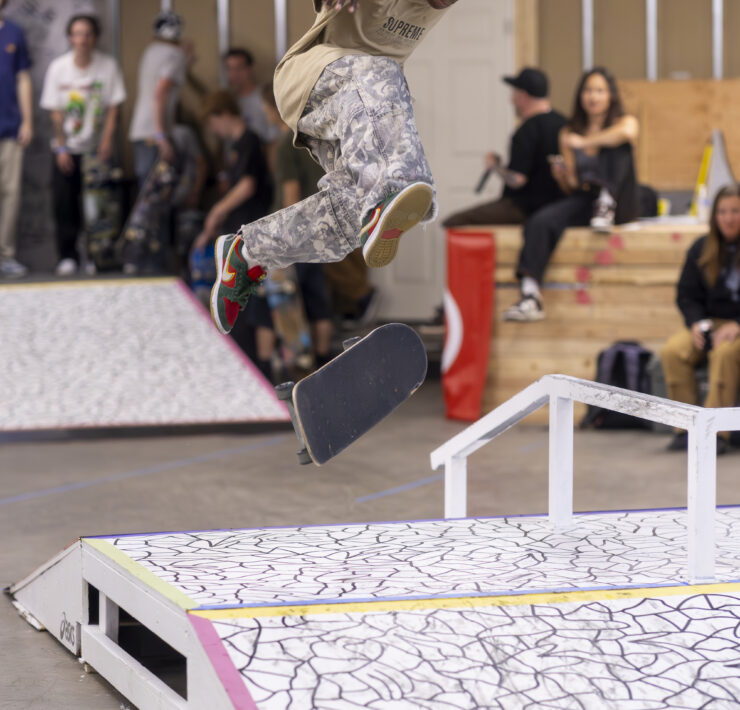Capoeira: It’s about love, not war

Two men crouch on the tiled floor. They make eye contact. They shake hands. They begin their dance.
One crawls like a crab into the center of the space. The other follows, head down, on all fours, his back arched like a camel. While rhythmic music plays from a speaker in the corner, the men circle each other, teasing almost, moving to the beat of an unspoken yin and yang.
The men are friends, but the game they play is much older than their friendship. It’s called capoeira, and it is a major part of Brazil’s cultural heritage.
“We are here to preserve nature, to get back in touch with our ancestry. Capoeira tries to bring people to a higher state of mind,” says José Geraldo Santos Souza, an expert in capoeira and one of the men practicing it in the upper floor of Sao Paolo’s Casa Jaya on July 22.
Originally practiced by African slaves on sugarcane and coffee plantations in colonial Brazil, capoeira consisted of a series of movements developed by slaves who sought to rebel against their masters. Santos said the movements often mimicked everyday activities like plating planting seeds or cutting with a machete, since they could be practiced without suspicion.
According to Santos and Capoeria-World.com, capoeira was outlawed for 50 years at the turn of the 20th century because of its widespread use in rebellions and uprisings. It became legal again in the 1940s, when individuals on the western coast of Brazil began teaching the movements in schools for self-defense, exercise and the preservation of traditions.
Today, capoeira is taught to children and adults of all races. It’s practiced in schools and community centers and places like Sao Paolo’s Casa Jaya restaurant, which Santos frequents as an instructor. The United Nations considers the game an intangible part of Brazil’s cultural heritage.
“In this place, we merge people on the fringes of society with people in the center of society,” Santos says. “It used to be about love and fighting, but now it’s about love, understanding and friendship.”

Santos grew up as a servant child in the home of a rich, white family in Rio de Janeiro. He cleaned, served and swept, receiving nothing more for his services than room and board and the clothes he wore. Those clothes were removed from time to time beginning when he was nine, he says, when the father of the family who employed him raped him.
“It was awful,” he said. “But on one hand, I wouldn’t take back [my time with them] because I learned things, like how to live formally and behave like the higher classes.”
Santos is now a 60-year-old self-made philanthropist with plans to open a community center for underprivileged children. He’s a part-time capoeira instructor and a respected craftsman. And he got to where he is now in life by following a simple life philosophy.
“I try to bring with me every good thing and leave the bad memories behind,” Santos said.
As soon as he turned 18, Santos left the rich family’s home and set out to make his own living. Soon he was able to study in a technical school, where he was trained in making hammers. After that, he expanded his skills to saddles, bags, shoes, hats, sculptures, and furniture. He also maintained a lively interest in capoeira, Brazil’s traditional game and a mixture of martial arts and dance, which he discovered at age 18 in Rio.
“I started doing it just for exercise, but then I learned who I really was, and that I was actually black,” Santos said.
In a nation whose inhabitants cherish European influence and tend toward racial whitening, admitting an African heritage is not often a popular act. Santos, though, said he found it liberating. He eagerly learned more about his great-grandfather, who was a slave, and his grandfather, who was born a freeman.
In this, capoeira helped. Santos said the activity is about bringing people together and fosters relationships between living people and their ancestors. He uses the “she” pronoun to refer to the game, emphasizing the spiritual change it can work in the people who play it.
“Capoeira is one whole story with a beginning, a middle, and an end. Her song expresses gratitude for everyone,” Santos said. “It’s about looking to the past to understand the present and the future.”
These days, Santos’ present consists of plenty of preparation for his future. He spends less time playing capoeira and more time landscaping and building a plot of land that he used his life savings to purchase. On it, he said he plans to open a community center in Coita, the eastern-Sao Paolo neighborhood where he resides.
Despite battles fought to keep nature – including deer and amarillos – on the land and encroaching favela residents off of it, Santos is full of enthusiasm. He said he wants to offer hope to children who might be in difficult situations like he was when he was young. Lessons in capoeira, craftsmanship, and more will be offered at the center.
“Many poor kids just need a hug,” Santos said. “They need attention.”
At the end of a morning of practice, Santos hugs his competitors, some of whom don’t speak his language. Sweat speckles his yellow t-shirt, and a smile radiates from his eyes.
“Capoeira is not only made out of movement,” he says, “but also of love.”
—
Victoria Ison is a Ball State University student and writer for Ball State at the Games, a group of 50 journalism students traveling from Muncie, Indiana, to Rio for the Olympic Games. Follow them at bsuatthegames.com, @bsuatthegames on Twitter and Instagram, and facebook.com/bsuatthegames on Facebook.










